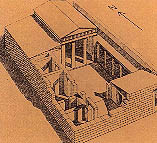
Solar design was largely abandoned in Europe after the Fall of Rome but continued unabated in China where cosmological traditions associate the south with summer, warmth and health. Nearly two and a half millennia ago, the ancient Greek philosopher Aeschylus wrote: "Only primitives & barbarians lack knowledge of houses turned to face the Winter sun." Similarly, Socrates said: "Now, supposing a house to have a southern aspect, sunshine during winter will steal in under the verandah, but in summer, when the sun traverses a path right over our heads, the roof will afford an agreeable shade, will it not?" Roman bathhouses had large south facing windows. Fully developed solar architecture and urban planning methods were first employed by the Greeks and Chinese who oriented their buildings toward the south to provide light and warmth. There is evidence that ancient cultures considered factors such as solar orientation, thermal mass and ventilation in the construction of residential dwellings. It has remained a traditional part of vernacular architecture in many countries.

The techniques of passive solar building design were practiced for thousands of years, by necessity, before the advent of mechanical heating and cooling.

In the 21st century, worldwide endeavours to reduce power consumption have kept the interest in passive solar technology alive. It was not until the 20th century that interest in the principles of passive solar design had a resurgence in Europe and the U.S.A., with architects such as George F.

Ancient Greeks, Romans, and Chinese were the first to refine and develop the basic principles of passive solar design, but European technological advances were largely abandoned after the Fall of Rome. The passive solar design of buildings includes consideration of their orientation to the sun and their thermal mass, factors which have been incorporated to a greater or lesser extent in vernacular architecture for thousands of years.


 0 kommentar(er)
0 kommentar(er)
